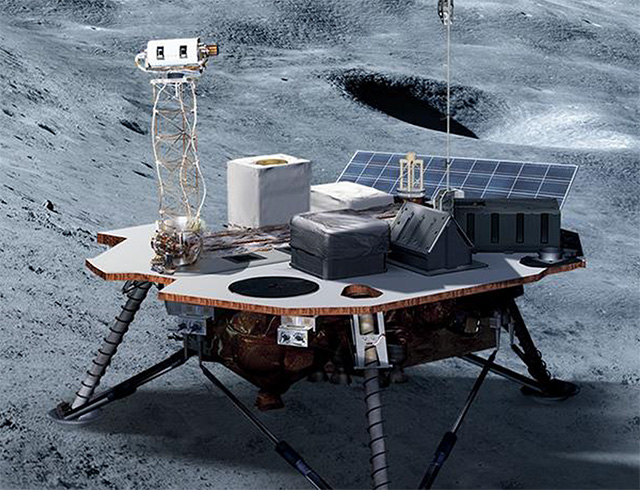
Audience
Educators, Students
Grade Levels
Grades 5-8, Grades 9-12
Subject
Engineering Design, Life Science, Space Science, Technology, Living and Working in Space, Solar System and Planets, Earth's Moon, Robotics
Type
Hands-on Activities, Lesson Plans / Activities
Introduction
As NASA travels to the Moon and beyond, a sustainable infrastructure must be established to ensure a lasting lunar presence. This will allow for greater exploration and study of the Moon. Astronauts will live and work in space for longer periods of time, which means that their access to supplies will be less immediate. What if we could generate products from materials that are contained within the Moon’s regolith (lunar soil)? This practice is called in-situ resource utilization (ISRU). Before Artemis astronauts land on the Moon, robots will scout the surface and collect information about the lunar South Pole. The data the robots gather will help scientists understand existing in-situ resources as well as assist in NASA’s search for water at the Moon’s poles. Additionally, robots could help identify and assess the abundance and quality of water in lunar areas expected to contain ice.
In this activity, participants will be challenged to compare the properties of ice with simulated icy-regolith, like the icy-regolith found on the Moon’s south pole and design a robot drill that will drill down into the simulated icy-regolith.
![]() Grade Range: 6-12
Grade Range: 6-12
![]() Time Needed: 60 Minutes
Time Needed: 60 Minutes
![]() Materials List
Materials List
Drill Bot (per team):
-
- Battery powered toothbrush (check discount stores for this item)
- Foam noodle or plastic cu
- Rubber band
- Electrical tape
- Metal washers or pennies
- Plastic spoon
- Craft sticks
- Chop sticks
- Push pin
- Paper clips
- Eye protection
Simulated Icy-Regolith:
-
- Container (e.g., ice cube tray, plastic cup)
- Sand
- Water
![]() Safety
Safety
Ensure participants:
-
- Are mindful of any potential student allergies regarding the supplies used in this activity.
- Wear eye protection when building and digging in the simulated icy-regolith.
- Practice safe cutting techniques and scissor handling when building their robot drill (drill bot). Confirm participants carefully support the piece being cut and are careful with placement of the supporting hand.
- Avoid moving about the room with scissors or other sharp objects.
- Tape the terminal ends of the batteries with electrical tape when they are not stored in their original packaging.
- Tape all bare wire and exposed electrical connections with electrical tape.
- Review their build with the educator before turning it on.
Activity Procedure
Preparation
-
- Gather and prepare all listed supplies.
- Group students into teams of three to five.
- Prepare water for icy-regolith:
- Fill half the container with water and half with sand. Place the container in the freezer overnight.
- Simulated icy-regolith must be used immediately once taken out of the freezer.
- Assemble the drill bot using the instructions on the last page of this activity as an example.
Procedure
-
- Allow students to see all the materials before building their drill bot.
- Have student teams create a sketch of their proposed drill bot, complete with labels and descriptions of the materials used.
- Have students keep in mind the following questions:
- How will you ensure that the digging device will not break?
- What mechanism will you use to ensure that the drill is breaking up the water ice?
- After reviewing each group’s drawing, allow students to retrieve the needed materials to construct their drill bot.
- Have teams construct their drill bot and ensure students are following safety protocols. Their drill bot must use only one device for digging (e.g., chopsticks, craft sticks, paper clip).
- Once students have created their own drill bot, allow them to test it on the simulated icy-regolith. Ensure teams are not adding any additional weight to their drill bot and are not using their hands to move the drill around. The vibration should move the drill.
- Ask these guiding questions as the teams work:
- Is the design working as expected?
- What can be improved to change it?
- What are the weaknesses in the design, and what can be done to overcome the weaknesses?
- Do you think additional weight needs to be added to the drill? If so, where would you add it?
Challenge Questions
-
- What are some of the difficulties your team faced during the initial design and build process, and how did you overcome them?
- Were you surprised at how difficult it was to drill through simulated icy-regolith?
- What impressed you about another teams’ model?
- How were you able to improve your design?
Extension
-
- Have participants design and create a drill bot using simple machines or a robotics kit.
- Include a small object in the icy-regolith, such as a penny, for the students to excavate with their drill bot.
Career Connection
Developing new technologies with robotics is an emerging field of study. The use of robotics in space requires a team of people with diverse expertise and specialized skills working together to develop the technology necessary to enable communication between the robot, astronauts, and Earth. Below are a couple of examples of the types of careers that will help in this effort.
Robotics careers develop, implement, and maintain technologies that deploy robotics. These types of careers focus on programming and smart manufacturing to ensure everything operates safely and efficiently.
Resource Extraction and Mining Technology careers focus on the efficient extraction of natural materials. This includes exploration, drilling, mining, and geosciences.
Other Resources
Digging on the Moon Student Activity
Interactive Mission with RT: Lunar Crater
The Polar Resources Ice Mining Experiment-1 (PRIME-1)
How Will We Extract Water on the Moon? We Asked a NASA Technologist




























